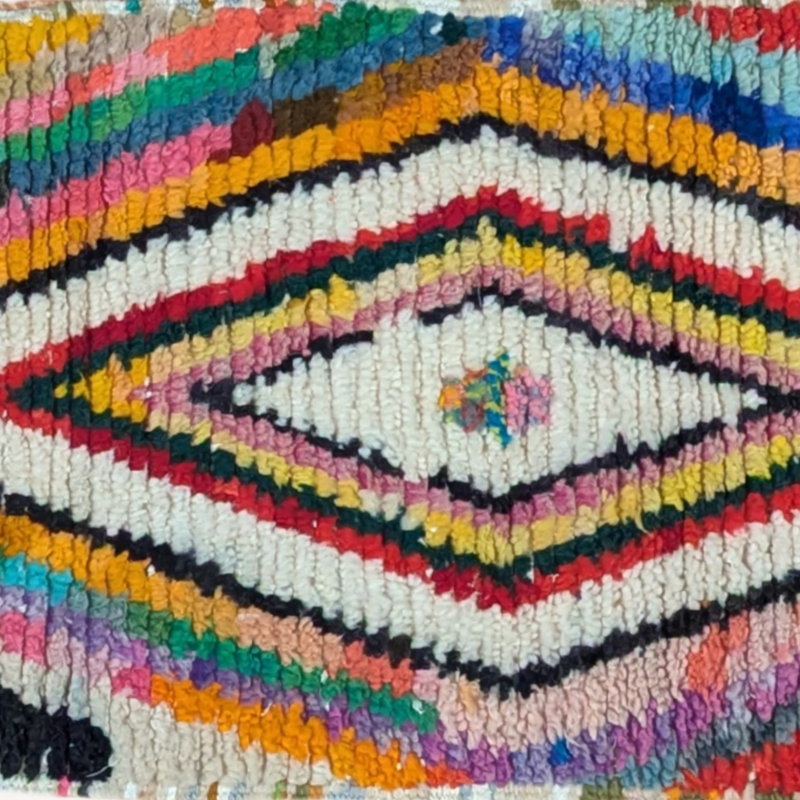How Much Does a Moroccan Rug Really Cost? A Complete Guide
Talking about Moroccan rugs and their prices isn’t easy. Sometimes it feels almost demeaning to reduce everything to economic terms, as these artifacts hold immeasurable value for us. Yet, we realize it’s time to address this topic, if only to explain how complex it is to determine the price of a Moroccan rug.
The first question that comes to mind for anyone looking to buy a Moroccan rug is: How much should I pay for a Moroccan rug? This is often followed by: Who should I turn to, and where should I go?
In this guide, we’ll explore the real cost of an authentic Moroccan rug, how to recognize quality, and where to buy ethically. We’ll also debunk some myths about bargaining and low-cost rugs. Let’s dive in!
What Makes a Moroccan Rug Authentic?
Before discussing prices, it’s crucial to understand what defines an authentic Moroccan rug. A true Moroccan rug must be made in Morocco, using traditional techniques and materials. Unfortunately, many rugs sold as “Moroccan” are actually produced in countries like India, Pakistan, or Turkey, often using industrial methods or synthetic materials.
Key Characteristics of Authentic Moroccan Rugs:
-
Materials: Traditional Moroccan rugs are made from natural fibers like wool, cotton, or recycled fabrics. Be cautious of rugs made with acrylic or synthetic materials.
-
Techniques: Authentic rugs are handmade, either woven or knotted, using traditional looms. Machine-made rugs lack the uniqueness and craftsmanship of handmade pieces.
-
Imperfections: Handmade rugs often have slight irregularities, which are a sign of their authenticity. Perfect symmetry or uniformity is a red flag.
-
Designs: Moroccan rugs feature traditional patterns and symbols that reflect the culture and history of the Amazigh (Berber) people.
How Much Does a Moroccan Rug Cost?
The price of a Moroccan rug depends on several factors, including materials, size, craftsmanship, and design complexity. Here’s a breakdown:
Factors Influencing the Price:
-
Materials:
-
Wool: High-quality wool rugs are more expensive due to their durability and softness.
-
Cotton: More affordable but less durable.
-
Silk: Luxurious and delicate, silk rugs come with a high price tag.
-
Synthetic fibers: Cheaper but lack the authenticity and quality of natural materials.
-
-
Size: Larger rugs require more material and labor, making them more expensive.
-
Craftsmanship:
-
Handmade rugs: These are labor-intensive and can take weeks or even months to complete. The time and skill involved significantly increase the price.
-
Machine-made rugs: Mass-produced and more affordable, but they lack the uniqueness of handmade pieces.
-
-
Design Complexity: Intricate patterns, custom designs, or rare color combinations can drive up the cost.
-
Origin and Brand: Rugs from well-known regions (like the Atlas Mountains) or reputable brands often come with a premium price due to their craftsmanship and cultural significance.
Price Ranges:
-
Budget-friendly: €50–€200 (machine-made, synthetic materials, smaller sizes).
-
Mid-range: €200–€800 (handmade, natural materials, medium sizes).
-
High-end: €800+ (luxury materials, custom designs, large sizes, and antique or vintage rugs).
The Truth Behind Low-Cost Rugs
The demand for affordable handmade rugs has led to the rise of exploitative practices. Many low-cost rugs are either:
-
Produced in countries with cheap labor: Rugs made in India, Pakistan, or China are often sold as “Moroccan style” but lack the authenticity and quality.
-
Made with synthetic materials: These rugs are less durable and often lack the cultural significance of authentic Moroccan rugs.
-
Produced under exploitative conditions: Workers, including children, are often underpaid and work in poor conditions.
When you buy a low-cost rug, you risk supporting unethical practices and receiving a product that won’t stand the test of time.
Where to Buy Moroccan Rugs Ethically
If you want to buy an authentic Moroccan rug while supporting ethical practices, here are your options:
-
Directly in Morocco:
-
Visit cooperatives or markets in cities like Marrakech, Fez, or Essaouira.
-
Be respectful when bargaining and show interest in the craftsmanship.
-
-
Specialized Online Retailers:
-
Look for e-shops that specialize in Moroccan rugs and provide detailed information about the origin, materials, and artisans.
-
Avoid generalist websites that sell “Moroccan-style” rugs at suspiciously low prices.
-
-
Auction Houses:
-
Auctions are a great option for antique or vintage rugs, but ensure the auction house provides certificates of authenticity.
-
-
Local Stores:
-
If you’re lucky, you might find a store in your city that sells authentic Moroccan rugs. Make sure they can provide information about the rug’s origin and craftsmanship.
-
Final Thoughts: What’s the Right Price?
The right price for a Moroccan rug is one that reflects its true value: the materials, craftsmanship, and cultural heritage behind it. While it’s tempting to look for bargains, remember that a low-cost rug often comes at the expense of quality and ethics.
When you invest in an authentic Moroccan rug, you’re not just buying a piece of decor—you’re supporting centuries-old traditions and the artisans who keep them alive. So, take your time, do your research, and choose a rug that tells a story you’ll cherish for years to come.






